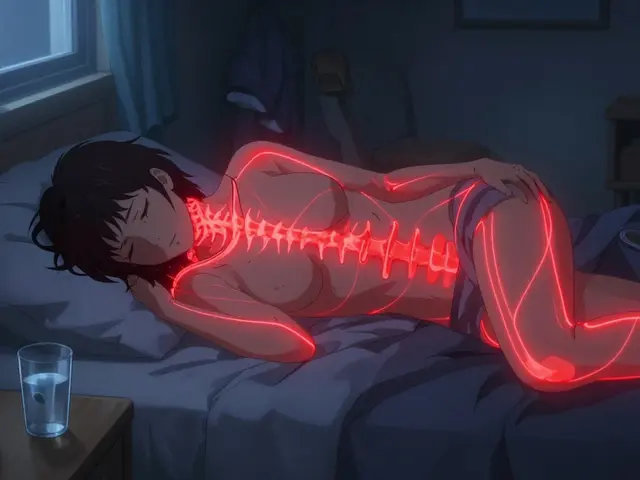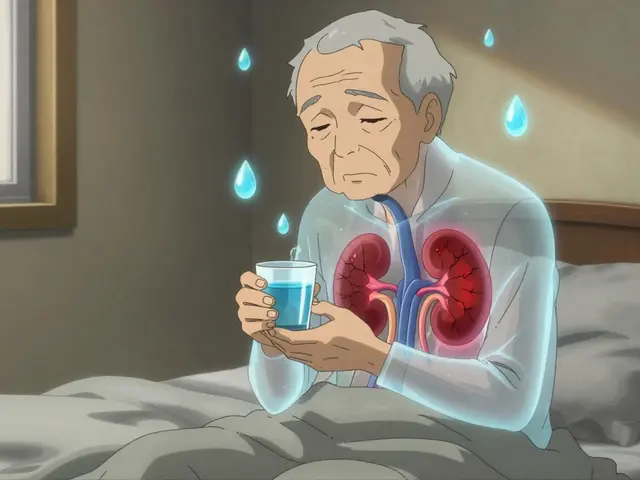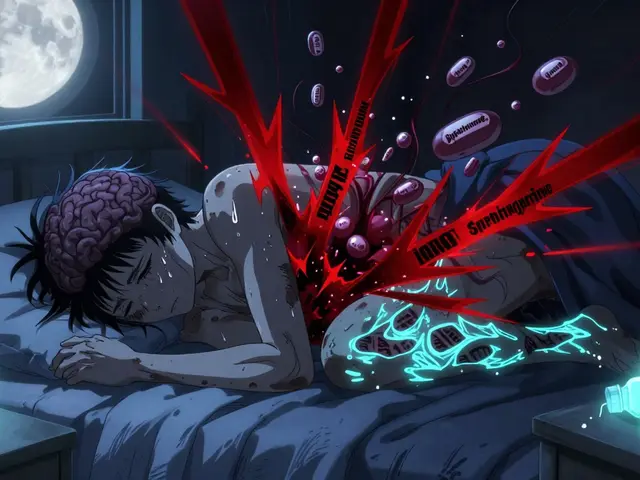
Health September 1, 2025
How to Rekindle the Spark When Low Libido Hits (Evidence-Based Guide)
You still love each other, but sex feels flat or far away. That can spook even solid couples. Here’s the good news: desire isn’t a switch; it’s a system. You can bring back heat by fixing small, fixable pieces-sleep, stress, scripts, and trust-without forcing it or faking it. Expect a few weeks of gentle changes, honest chats, and playful experiments. That’s how spark returns for real.
- TL;DR: Most couples go through desire dips. Tackle pressure, pain, sleep, stress, meds, and routine. Rebuild touch, talk clearly, and add novelty in small steps.
- Start with a 7‑day reset: pressure-free intimacy, daily touch, sleep fix, and one honest conversation using the scripts below.
- Check root causes: hormones, mental health, relationship tension, medications, pain. Use the table and decision tree to pick the next move.
- Use the 30‑3‑1 and 2‑2‑2 rules, a yes/no/maybe list, and a simple desire check-in. Schedule sexy on-ramps; let sex be the ride, not the test.
- If distress lasts 3+ months, or there’s pain, see your GP. In the UK, ask for psychosexual therapy and check registers like COSRT or BACP.
A step-by-step plan to reconnect (without forcing it)
Low desire usually isn’t about love. It’s about load. Work, worry, body changes, meds, sleep debt, the same routine-your body hits the brakes. Fix the brakes, and the car moves. Here’s a practical plan you can start tonight. It’s gentle, honest, and built for busy lives.
low libido can make you doubt yourself or your bond. You’re not broken. This plan shifts the focus from “perform” to “connect,” and from “must” to “maybe.” It blends what we know from sex therapy, relationship science, and everyday life.
- Set a new contract for 14 days: connection over climax. Agree you’re pressing pause on goal-driven sex. No one owes anyone an orgasm. You’re exploring touch, time, and talk. Take the pressure to zero. Pressure kills desire faster than almost anything.
- Use the 30‑3‑1 framework.
- 30 seconds: a real hug and a 6‑second kiss once a day (the Gottman Institute calls it a “six-second kiss” for a reason-it builds bond and lowers stress).
- 3 date moments per week: not full dates-just 20 minutes of phones-down time (walk after dinner, coffee in the garden, a shared show you actually talk about).
- 1 sex talk per week: a 10-minute, clothes-on check-in using the scripts below.
- Switch to “intimacy nights,” not “sex nights.” Pick two evenings a week where the only plan is warmth. Light touch, massage, shower together, or kissing. If desire shows up, great. If not, still a win. This trains your brain to link closeness with safety, not pressure.
- Fix the easy brakes first:
- Sleep: aim for 7-9 hours. Sleep drives hormones and desire. Even one extra hour can help.
- Stress: a 20‑minute wind-down before bed (stretch, shower, light snack) nudges your body out of fight-or-flight.
- Alcohol: cut back; it raises interest at first but dulls arousal later.
- Screen swap: move phones out of the bedroom. Curate the space for rest and touch.
- Make desire easier to find. Desire is often “responsive,” not “spontaneous.” That means it follows comfort and arousal. Try a 10-minute “on‑ramp”: warm shower, music you both like, a short back rub, then gentle kissing. Let arousal build before you decide about sex.
- Use this simple check-in once a week.
- Green: keen to explore.
- Yellow: open, need warm-up.
- Red: not today; want closeness only.
- Write a yes/no/maybe list. Separately mark touch ideas you’d enjoy (yes), might try (maybe), or don’t want (no). Swap lists. Build a menu that makes both of you feel curious and safe.
- Upgrade physical comfort. Pain or dryness switch desire off. Use a generous silicone or water-based lubricant, try longer warm-ups, and slow down. If there’s any pain, treat that first (see fixes below).
- Bring back novelty in tiny doses. Newness wakes the brain. Swap location (sofa, different room), time of day, or roles (the giver/receiver game). Think playful, not performative.
- Use the 2‑2‑2 rule. A date every 2 weeks, a night away every 2 months, and a getaway every 2 years. Make a budget-friendly version if needed (home picnic, house swap, tent in the garden).
Conversation scripts that keep it kind
- “I miss feeling close. Can we try a no-pressure cuddle night twice a week and see what feels good?”
- “My body’s been in stress mode. I want us to have more warmth while I figure out the basics-sleep, meds, and stress.”
- “I’m a yellow tonight. How about a shower together and a long kiss, then we see?”
- “I love you; this isn’t about attraction. My desire dips when I’m tired or rushed. Can we start earlier and go slow?”
Heuristics that help
- 30% buffer: stop screens 30 minutes before bed. Use that slot for touch or talk.
- 6‑second rule: one full, present kiss daily.
- 80/20 novelty: keep 80% familiar, add 20% new. Too much change can feel unsafe.
- 3:1 praise to ask ratio: appreciate three things for every ask you make.

Find the cause: body, mind, meds, and relationship load
Desire dips have patterns. When you match the pattern, you can choose the right fix. Use this section to spot likely causes, then take the next clear step. When in doubt, start with sleep, stress, and pain. Then check meds and hormones. Last but not least, update your couple habits.
| Issue | How common | Clues | What helps | Credible source |
|---|---|---|---|---|
| Lack of interest in sex (past year) | ~34% of women; ~15% of men in UK report it | Interest drops, especially under stress or after kids | Pressure-free intimacy, sleep, stress care, novelty | Natsal‑3 (UK pop. survey) |
| Distressing low desire | ~13% of women; ~8% of men | Worry about it, strain in relationship | GP review, psychosexual therapy | Natsal‑3; NHS |
| SSRI sexual side effects | 30-50% experience some sexual effect | Started after antidepressant change | Switch/adjust meds (e.g., bupropion or vortioxetine), timing | Royal College of Psychiatrists |
| Sleep and desire | Each extra hour linked to higher next‑day desire in women | Crashes when sleep <7h | 7-9h sleep, 20‑min wind‑down | University of Michigan study (2015) |
| HSDD in premenopausal women | ~8-10% | Persistent low desire with distress ≥3 months | CBT/sex therapy, med review; selected cases meds | ISSM/ISSWSH guidance |
| Perimenopause/menopause | Common; estrogen/testosterone shifts | Dryness, hot flushes, brain fog | Vaginal oestrogen, HRT; consider testosterone in select cases | NHS; NICE; British Menopause Society |
| Sexual pain (dyspareunia) | Up to 10-20% at some point | Pain, burning, tightness | Lube, treat infections, pelvic floor physio, topical therapies | NICE; Cochrane reviews |
| Chronic stress/anxiety | Very common | Tense body, racing mind | Mindfulness, exercise, therapy; slower, longer warm‑up | NICE; NHS Talking Therapies |
Medical and medication checks to consider (UK‑friendly)
- Meds that can blunt desire: SSRIs/SNRIs, some blood pressure meds, combined hormonal contraception for some, finasteride, opioids. Never stop on your own-ask your GP about alternatives or dose timing.
- Alternatives with fewer sexual effects: bupropion or vortioxetine (for depression), different antihypertensives, or a non‑hormonal contraceptive. This needs a clinician’s call.
- Hormones: perimenopause can bring dryness and desire dips. Vaginal oestrogen is safe for most and very effective for comfort. Systemic HRT can help symptoms that indirectly tank desire (sleep, mood, hot flushes). UK guidance allows carefully dosed testosterone for postmenopausal women with persistent low desire after HRT-ask a menopause‑trained clinician.
- Postpartum: libido often dips for 3-6 months (sleep loss, hormones, body healing). Start with touch and comfort, not penetration; lube is your friend.
- Health screens worth doing: iron/B12 (if fatigued), thyroid, HbA1c (diabetes risk), medication review, mental health check. Treat the body, and desire follows.
Relationship and mind patterns
- Responsive desire: Many people don’t feel “in the mood” until after arousal starts. That’s normal. Build the on‑ramp.
- Gridlock topics: Money, chores, in‑laws, parenting. Recurrent fights push bodies into guard mode. Try a weekly 45‑minute “admin meeting” to handle logistics away from the bedroom.
- Turn‑toward habit: When your partner bids for attention (a sigh, a “look at this”), turn toward, not away. Micro‑moments add up to macro desire.
- Erotic monotony: Same script, same timing. Keep 80% familiar, add a 20% twist-a new touch, a new angle, a playful dare.
Pain = priority one
- Use lube every time if dryness or friction shows up. Water‑based for most; silicone-based lasts longer and is great for menopause/postpartum. Check toy/condom compatibility.
- If pain persists, ask your GP for a vulvovaginal exam; rule out infections, skin conditions, and vestibulodynia. Pelvic floor physio and gradual desensitisation often help a lot.
- For penises, pain or curvature needs a check; ED’s vicious cycle responds to honest talk, slower build‑up, and medical treatment if needed.
Decision tree (pick your next move)
- “My desire crashed right after a new med.” → Talk to your prescriber about options or timing; don’t stop alone.
- “It hurts.” → Treat pain before chasing desire: lube, slower warm‑up, GP, pelvic floor physio.
- “I’m exhausted.” → Sleep first. Protect one earlier night a week for intimacy.
- “We’re tense with each other.” → Two weeks of pressure‑free touch + one honest weekly chat using the scripts.
- “It’s been months and I’m upset about it.” → Book a GP review and ask for a psychosexual therapy referral; consider registered therapists (COSRT/BACP).

Tools, checklists, mini‑FAQ, and next steps
Here’s your quick kit: short scripts, a weekly checklist, realistic schedules, and what to do when life stages (new baby, menopause, long distance, mental health) complicate things. Use what fits; ignore what doesn’t.
Weekly intimacy checklist (10 minutes on Sunday)
- Did we do one 6‑second kiss daily? If not, plan when.
- Did we have two intimacy nights? Book them now.
- Is sleep wrecking us? Pick one early night together.
- Any pain or side effects? Note it and message GP if needed.
- What tiny novelty can we try this week?
Sample 7‑day reset
- Day 1: Agree the no‑pressure contract, swap yes/no/maybe lists.
- Day 2: Bedroom reset-remove screens, fresh sheets, add a warm lamp.
- Day 3: 20‑minute walk holding hands; end with a 6‑second kiss.
- Day 4: Shared shower or massage; no goal, just warmth.
- Day 5: Early night. Read or cuddle. Kiss. Stop if either of you wants to.
- Day 6: Try a new touch or location (sofa cuddle + blanket).
- Day 7: 10‑minute sex talk. What worked? What should we keep or drop?
Yes/no/maybe prompt list ideas
- Yes: back rub with oil, shower together, kissing without talking, spooning.
- Maybe: mutual massage with timer, guided audio erotica, toys together, morning sex.
- No: anything painful, rushed penetration, sex during high-stress evenings.
When life stages change everything
- New parents: Expect 3-6 months of low libido. Nap dates beat late nights. Focus on touch and small erotic moments. Lube and patience.
- Perimenopause/menopause: Treat dryness with vaginal oestrogen; ask about HRT to fix sleep and hot flushes. Testosterone may help in selected cases after other treatments-UK clinicians can advise.
- Long‑distance: Keep the daily 30 seconds (voice note or video kiss). Plan an on‑ramp for reunions-start with touch, not instant sex.
- Neurodiversity: Predictable scripts and sensory-aware touch plans help. Ask about pressure points, textures, and timing that feel safe.
- Mental health dips: Depression and anxiety blunt desire. Treat the mood, and sex follows. Therapy first; intimacy nights stay gentle.
Pro tips from the therapy room
- Clothes-on first: Heavy petting is not a downgrade; it’s a warm-up.
- Silent timer: Three minutes per partner for receiving-only touch, then swap. Pressure and chatter drop; sensation rises.
- Anchor scent: Use the same candle or oil on intimacy nights. Your brain will pair it with calm and arousal.
- Sexual boredom hack: Change one variable (location, pace, lead/follow) at a time.
Mini‑FAQ
- How much sex is “normal”? There isn’t a normal. What matters is that both of you feel content. If it’s a problem for either of you, it’s worth care.
- Does scheduling kill spontaneity? It usually does the opposite. You plan the on‑ramp so spontaneity can show up.
- What if we don’t match on desire? Meet in the middle without resentment: more affectionate touch for both, more responsive desire time for the lower‑desire partner, more solo sex and fantasy freedom for the higher‑desire partner. Nobody gets everything; everyone gets something real.
- Are toys and erotica okay? If they’re consensual and safe, yes. They can add novelty and help responsive desire. Keep lube handy and check material safety.
- When should we see a professional? Pain; sudden, unexplained changes; distress lasting over three months; or if trauma or mental health is in the mix. In the UK, start with your GP. For therapy, look for COSRT-accredited psychosexual therapists or BACP-registered counsellors. Relate also offers couple work.
Red flags not to ignore
- Any sexual pain that doesn’t improve with lube and slower warm‑up.
- Bleeding after sex, new discharge, or sores-book a check.
- Sudden desire loss with other symptoms (low mood, hair changes, weight shifts)-ask about thyroid, anaemia, diabetes, or medication effects.
- Coercion or pressure-desire can’t grow without safety.
Realistic UK next steps
- Book a GP appointment: ask for a medication review, hormone discussion, and referrals (pelvic floor physio, psychosexual therapy).
- Ask about NHS Talking Therapies if anxiety or low mood are present.
- For specialist help, check registers: College of Sexual and Relationship Therapists (COSRT) and the British Association for Counselling and Psychotherapy (BACP). Many offer online sessions.
- Menopause care: seek a clinician trained in menopause; ask about vaginal oestrogen, HRT options, and whether testosterone is appropriate for you.
Troubleshooting by scenario
- “I never feel ‘in the mood’ anymore.” → Switch to responsive desire: always start with a 10‑minute on‑ramp. Decide after arousal begins, not before.
- “I want sex, my partner doesn’t.” → Lead with connection. Offer touch that doesn’t expect sex. Encourage solo pleasure for yourself to reduce pressure on the couple space.
- “Foreplay feels like a chore.” → Rename it “warm‑up” and make it for the giver, too. Use a timer so it ends before anyone gets antsy.
- “Porn use is a wedge between us.” → Set shared rules. Talk about meaning, not morality. Try a break and add couple-focused novelty while rebuilding trust.
- “We try, then we freeze.” → Add a stop-word that means “pause, cuddle, and breathe.” Build safety first. Try again another day.
I’ve seen couples in Bristol and beyond turn dry spells into warmer seasons with small, steady shifts. Desire isn’t magic; it’s a mix of biology, context, and care. When you lower pressure, fix simple barriers, and invite curiosity back in, the spark returns-often quietly at first, then with more confidence. Give it a month of patient practice. You may surprise yourselves.
Write a comment
Items marked with * are required.






14 Comments
Abhay Chitnis September 8, 2025 AT 01:19
LMAO this is just relationship self-help porn. 🤡 You don't fix desire by hugging longer-you fix it by not being emotionally bankrupt. My wife and I haven't had sex in 11 months and we're both fine. Stop treating intimacy like a to-do list.
Robert Spiece September 8, 2025 AT 17:35
Ah yes, the classic "fix your libido by doing yoga and saying "I miss feeling close"" manual. Let me guess-next they'll tell us to journal our erections and meditate on our clitoral arousal cycles. This isn't science. It's corporate wellness theater dressed up as therapy.
Vivian Quinones September 9, 2025 AT 04:42
This is why America's falling apart. You can't fix desire with 6-second kisses and "maybe" lists. Back in my day, you just did it because you loved each other-not because you scheduled a "connection night" like it's a dentist appointment. 🇺🇸
Eric Pelletier September 10, 2025 AT 16:51
Actually, this is grounded in evidence-based sex therapy. The 30-3-1 framework aligns with Gottman's research on bidirectional emotional connection, and the responsive desire model is well-documented in Basson's circular model of female sexual response. Sleep hygiene and stress modulation directly impact cortisol and testosterone levels-peer-reviewed studies confirm this. The real issue is people mistaking behavioral nudges for "magic tricks."
Marshall Pope September 11, 2025 AT 12:52
i tried the 30-3-1 thing for a week. we did the hugs and the shower thing. still no spark. maybe im just broken. idk. maybe we just dont wanna anymore. its fine. 🤷♂️
Nonie Rebollido September 12, 2025 AT 03:53
Honestly? I love how this doesn't shame people for having low libido. So many people act like it's a moral failure. I'm just glad someone said "it's okay to be yellow." 🌈
Agha Nugraha September 13, 2025 AT 15:49
This is actually really useful. I'm from India and we never talk about this stuff. My wife and I have been married 8 years and I never knew how to bring it up. This gives me words. Thank you.
Andy Smith September 14, 2025 AT 19:00
I appreciate the nuance here. The 80/20 novelty rule is critical: too much change triggers threat response in the limbic system; too little triggers habituation. The yes/no/maybe list is a brilliant application of nonviolent communication principles. And the 3:1 praise-to-ask ratio? That’s pure emotional regulation science. This isn’t fluff-it’s applied neurobehavioral psychology.
Rekha Tiwari September 15, 2025 AT 02:22
This made me cry 😭 I thought I was the only one who felt this way. My husband and I have two kids, and I haven't felt like "me" in years. We tried the 6-second kiss and I actually felt seen for the first time in months. Thank you for writing this like a human. 💖
Leah Beazy September 15, 2025 AT 10:07
Y'all need to stop overthinking this. I'm a mom of three, work 60 hours a week, and I just started doing 10 minutes of stretching with my husband before bed. We don't talk about sex. We don't schedule it. We just touch. And guess what? Last week, we ended up having sex. Not because we "tried," but because we finally stopped trying. 🙌
John Villamayor September 17, 2025 AT 06:50
In my culture we dont talk about this. But this advice is actually not bad. The sleep thing is real. My cousin in Pakistan said his wife lost desire after he started scrolling until 2am. He moved his phone out and they started talking. Now they have sex twice a week. Simple
Jenna Hobbs September 17, 2025 AT 14:08
I just want to say-this is the most beautiful, tender, REAL thing I've read in years. 🥹 You didn't just give a checklist-you gave permission. Permission to be tired. Permission to say "no." Permission to be human. I'm printing this out and taping it to our bathroom mirror. Thank you.
Ophelia Q September 18, 2025 AT 16:52
I was so ashamed of my low libido until I read this. I thought I was broken. Turns out I just had 3 hours of sleep a night for 2 years. Fixing sleep + cutting alcohol = my body remembered how to want. Not magic. Just biology. 🙏
Elliott Jackson September 19, 2025 AT 05:07
I've been married for 15 years and I've read every single "how to fix your sex life" article ever written. This one? Honestly? It's the only one that didn't make me want to throw my phone out the window. I'm actually going to try the yes/no/maybe list. Not because I think it'll work-but because I'm tired of pretending I'm fine.